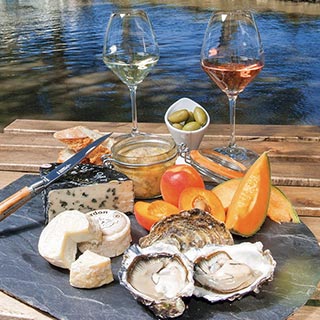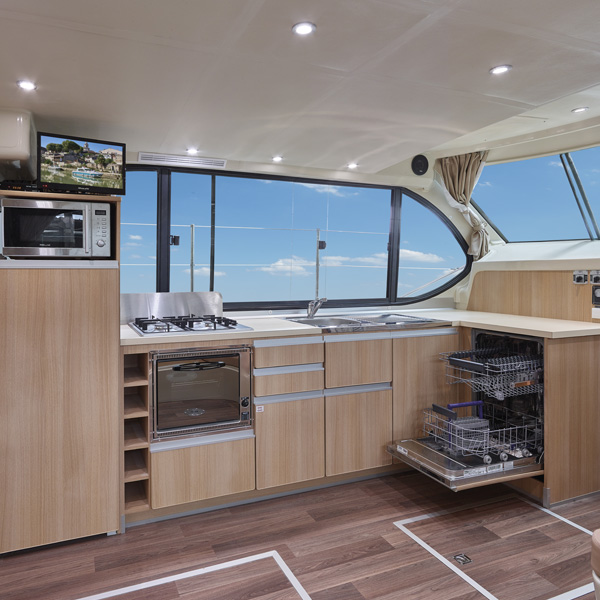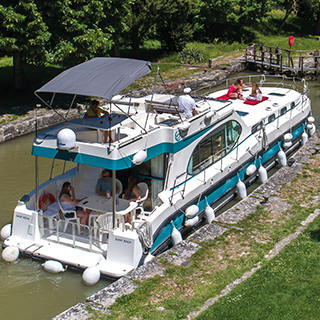Glossary of navigation terms
B
BABORD (PORT)
Left side of the boat when looking forward.
BAJOYER (LOCK WALL)
Sidewall of a lock, whether vertical or slightly inclined.
BARRE (STEERING WHEEL)
This is the steering apparatus for the boat – it could be a wheel, like that of a car of a tiller – a long handle at the rear of the boat
BATTRE EN ARRIERE (Reverse to stop)
Put the boat in reverse to stop it.
BIEF
Part of watercourse or canal between two locks.
BIEF DE PARTAGE
The highest point on the canal where the watershed is located.
BITTE D'AMARRAGE (MOORING POST)
A metal or concrete mooring point affixed to the bank or quay which makes it possible to be moor the boat.
C
CHEMIN DE HALAGE (TOWPATH)
Path alongside the canal or river which was used until the beginning of this century for horses or men to pull barges.
CHENAL DE NAVIGATION (NAVIGABLE CHANNEL)
This is the navigable area indicated on the maps that you must follow very carefully to avoid any danger such as rock, silting, pegs etc.
E
ETIAGE (LOW WATER LEVEL)
The lowest level of a watercourse or canal.
F
FARDAGE (FREEBOARD / WINDAGE)
Part / volume of the boat above the waterline. The higher the volume above the water, the more your boat offers a great hold to the wind. So always take this into consideration for your manoeuvres.
G
GAFFE (BOAT HOOK)
Long wooden or metal pole with a hook at one end. The use of your gaffe during docking or unloading, in the locks, will facilitate manoeuvres and avoid shocks to the boat.
L
LISTON (BUMPER)
Band of rubber or wood running around the hull of the boat to protect it. Almost all boats are equipped with a liston (often only one, two or even three on some models) to which is added the additional protection offered by fenders.
M
MONTANT (TRAVELLING UPSTREAM)
Boat navigating upstream, that is to say, it is travelling against the direction of the of the current, heading towards the source. On a canal, this means that the boat takes the locks in the uphill direction (like a staircase).
MOUILLAGE (DEPTH)
Depth of a waterway (such as a canal or river at 1.40 m of mooring, for example).
P
PARRE-BATTAGE (FENDERS)
Round or oval protection devices - inflated with compressed air and arranged in a string around the hull to protects it from possible shocks. In general there will be 8 to 20 of these items which are designed only to burst only under violent shocks and should be left in place even if you consider them unsightly.
POUPE (STERN)
Rear of the boat
PROUE (BOW)
Front of the boat
S
SAS (LOCK SIZE)
This is the part of the lock between the two upstream and downstream gates.
SASSEMENT (LOCK CYCLE)
The duration of time that a boat remains in a lock. This depends on the height of the fall as well as the size of the lock. In general, it takes about fifteen minutes per lock cycle.
SEUIL
A kind of step located on the side of the upstream door in a lock which must be used with great care.
T
TAQUET (CLEAT)
Metal fixing piece on a boat where you can attach and tie a mooring. In general, the boats are equipped with two cleats at the stern and one or two cleats at the bow.
TIRANT D'AIR (Freeboard)
Height between the water level and the keystone of a structure such as a bridge.
TIRANT D'EAU (Draft)
Vertical distance between the lowest part of a boat (usually the keel) and the waterline.
TREMATAGE (Overtaking)
The action of overtaking a boat travelling in the same direction.
TRIBORD (STARBOARD)
Right hand side of the boat when looking forward

























